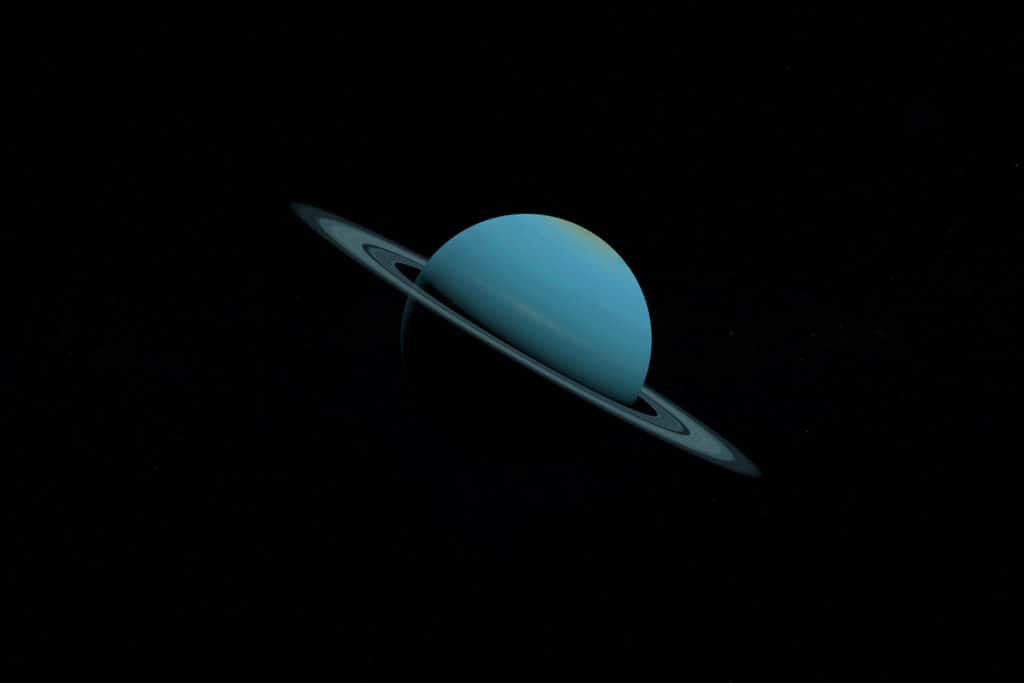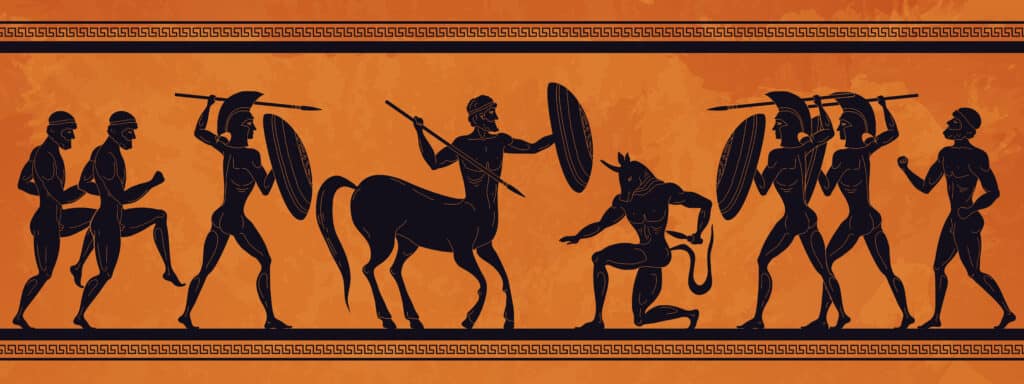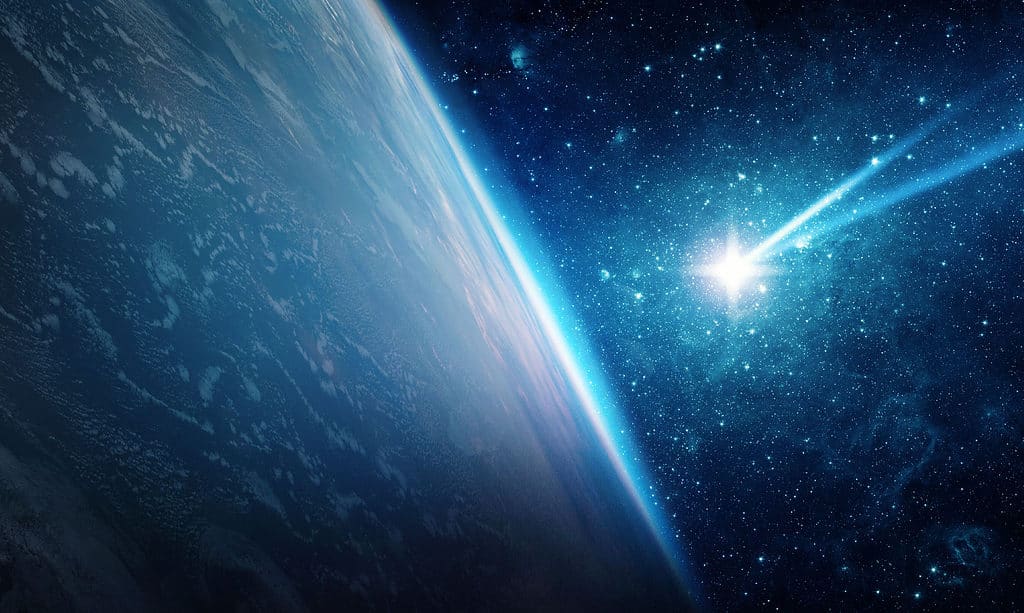Of all the planets in our solar system, Uranus is one of the most unique. Discovered in 1781 by William Herschel, it was the first planet to be discovered using a telescope. Gradually in the centuries since then, Uranus has continued to reveal its strange and wonderful secrets: its pale blue color, its tilted axis, its moons, its thin ring system, and more. Going on from here, we’ll answer the question: “how large is the planet Uranus?” as well as share a lot of other extremely interesting facts about this enormous, weird, and wonderful planet.

Planet Uranus has several rings.
©iStock.com/Ianm35
Uranus: History and Description
Uranus is the seventh planet in our solar system. Along with Jupiter, Saturn, and Neptune, it is one of the “giant planets.” With a magnitude of only 5.38-6.03, it can just barely be seen with the naked eye. The few times it was noted by ancient astronomers, they just thought it was another star. In 1781, though, William Herschel managed to make it out more clearly as a planet, with the help of a telescope, making this the first time a planet was discovered with a telescope. It was named Uranus after the ancient Greek sky god Ouranos.

The name of Uranus is derived from Greek mythology.
©SpicyTruffel/Shutterstock.com
Uranus: Fascinating Facts
As time went on, astronomers have learned more interesting facts about Uranus:
- Uranus is the third largest planet in the solar system and the 7th planet from the sun.
- Even though it is not the farthest planet from the sun, it has the coldest temperature, with an average temperature of -357 degrees Fahrenheit (-216 degrees Celsius).
- It takes 84 earth years for it to orbit the Sun.
- Uranus rotates on its axis in just 17 hours, yet because the planet’s poles face toward and away from the sun, each hemisphere of the planet has 42 years of sunlight followed by 42 years of darkness.
- Astronomers think the planet was hit by a large asteroid billions of years ago that caused the planet to develop a 98-degree tilt on its axis.
- It orbits 2 billion miles (3 billion kilometers) from the sun, about 20 times further from the Sun than the earth.
- Sunlight on Uranus is only about 1/400 as bright as it is on Earth. It takes light 2 hours and 40 minutes to reach it from the Sun.
- The orbit of Uranus is more elliptical than any of the other planets. Irregularities in it helped astronomers discover the planet Neptune, which creates a gravitational pull on Uranus.
- Uranus has 11 thin rings that were only discovered in 1977. They are made of particles ranging in size from dust to boulders.
- This planet has 27 moons. Each moon is named after characters from the writings of William Shakespeare and Alexander Pope. The largest moons are named Titania, Oberon, Umbriel, Ariel, and Miranda.
- Methane gas in the atmosphere gives it a distinctive blue-green color.

Astronomers think Uranus was hit by a very large asteroid billions of years ago, which resulted in the planet being tilted on its axis.
©Triff/Shutterstock.com
Uranus: Mass
Of the four giant planets, Uranus is the smallest with a mass of 8.681 × 10^25 kg (1.913839 × 1026 lbs). This is still vastly larger than the earth: 14.5 times bigger, to be precise. This also means if you visited Uranus, you would weigh a lot more than you do on earth. Check out this article to find out exactly how much: This Is How Much You’d Weigh on Uranus. And see the chart below to find out how the mass of Uranus compares to the Sun, the other planets of our solar system, and the dwarf planet Pluto.
| Mass | Number of Earths | |
|---|---|---|
| Sun | 1.988435 × 1030 kg 4.38442 × 1030 lbs | 333,000 |
| Jupiter | 1.899 × 1027 kg 4.18658 × 1027 lbs | 317.8 |
| Saturn | 5.6846 × 1026 kg 1.25361 × 1027 lbs | 95.2 |
| Neptune | 1.0243 × 1026 kg 2.25858 × 1026 lbs | 17.1 |
| Uranus | 8.6832 × 1025 kg 1.913839 × 1026 lbs | 14.5 |
| Earth | 5.9742 × 1024 kg 1.31629 × 1025 lbs | 1 |
| Venus | 4.8685 × 1024 kg 1.07323 × 1025 lbs | 0.815 |
| Mars | 6.4185 × 1023 kg 1.41469 × 1024 lbs | 0.107 |
| Mercury | 3.302 × 1023 kg 7.27923 × 1023 lbs | 0.0553 |
| Pluto | 1.305 × 1022 kg 2.87769 x 1022 lbs | 0.0022 |
Uranus: Surface Area
So how does the surface area of Uranus compare with other celestial bodies in our solar system? That’s a harder question to answer, depending on what we consider to be the surface of Uranus. The planet has a small rocky core only half the size of the earth. This is surrounded by the mantle: a vast partially frozen ocean of water, ammonia, and methane ice. Finally, the last 20% of Uranus’s radius is a thin upper atmosphere. Because so much of Uranus and Neptune are made of frozen elements rather than gases, they are classified as “ice giants” rather than “gas giants” like Jupiter and Saturn. Based upon the measured diameter of the planet, Uranus has a surface area of 8.1156 × 109 km2 (3.13355 x 109 mi2). Here’s how that ranks compared to its neighbors, and in terms of the Earth’s surface area:
| Surface Area | Number of Earths | |
|---|---|---|
| Sun | 6.07877 x 1012 km2 2.34613 x 1012 mi2 | 11,917.607 |
| Jupiter | 6.1419 x 1010 km2 2.36886 x 1012 mi2 | 121.9 |
| Saturn | 4.27 x 1010 km2 1.64727 x 1010 mi2 | 83.7 |
| Uranus | 8.1156 × 109 km2 3.13355 x 109 mi2 | 15.91 |
| Neptune | 7.6408 x 109 km2 2.94723 x 109 mi2 | 14.98 |
| Earth | 5.100656 x 108 km2 1.96907 x 108 mi2 | 1 |
| Venus | 4.60 x 108 km2 1.77699 x 108 mi2 | 0.902 |
| Mars | 1.44798465 x 108 km2 0.55831 x 108 mi2 | 0.284 |
| Mercury | 7.48 x 107 km2 2.88617 x 107 mi2 | 0.147 |
| Pluto | 1.67 × 107 km2 0.6445 x 107 mi2 | 0.035 |
Uranus: Diameter
In diameter, Uranus is 51,118 km (31,748.12 mi): about 4 times the diameter of Earth. It’s very close in size to Neptune. To put that in perspective, if the Earth were the size of a nickel, Uranus would be as big as a softball. Here’s how that compares to the Sun and other planetary bodies:
| Diameter | Number of Earths | |
|---|---|---|
| Sun | 1,392,700 km 864,938.31 mi | 109 |
| Jupiter | 142,800 km 88,750.04 mi | 11 |
| Saturn | 120,660 km 74,981.31 mi | 9 |
| Uranus | 51,118 km 31,748.12 mi | 4 |
| Neptune | 49,528 km 30,788.25 mi | 4 |
| Earth | 12,756 km 7,926.39 mi | 1 |
| Venus | 12,104 km 7,523.06 mi | 1 |
| Mars | 6,779 km 4,214.39 mi | 0.5 |
| Mercury | 4879.4 km 3,031.35 mi | 0.33 |
| Pluto | 2,376.6 km 1,477.61 mi | 0.185 |
So there you have it, everything you ever wanted to know about the strange and wonderful planet Uranus, which has slowly yielded its secrets to science. We know what gives it its color, how big it is, and how many moons and rings it has. What other secrets does it still conceal? Who knows? Maybe people will be able to travel there in person one day to see it with their own eyes. And maybe you or your children or grandchildren will be among them.
The photo featured at the top of this post is © iStock.com/IncrediVFX
Thank you for reading! Have some feedback for us? Contact the AZ Animals editorial team.







